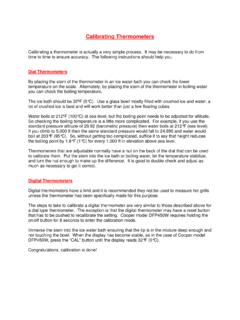Transcription of European Instruments - ei.co.uk
1 European Instruments Shotover Kilns, Old Road, Headington, Oxford. OX3 8ST Tel: 01865 750375 Fax: 01865 769985 email: web: UKAS Balance / Scale Application Form APPENDIX III (Please complete prior to visit). SUBMITTER (address to appear on certificate): CLIENT (If different from submitter): CALIBRATION METHOD. We will calibrate your equipment in accordance with our UKAS accreditation, 0438. We will carry out tests for Repeatability, Linearity & Eccentricity over the Instruments whole range only. We will carry out an As Found 5 point linearity calibration followed by a Post Adjustment calibration where we will activate the adjustment routine (calibration function) using the internal calibration mechanism (if equipped) or externally applied UKAS certified weight, and the calibration performed according to the calibration method stated above.
2 We will detail the environmental conditions at the time of calibration and we will issue a UKAS Certificate that will detail the Uncertainty of Measurement. Prior to visit please ensure: i) Equipment is located in its normal place of use, ii) Any pre weighing checks carried out before use have been completed iii) Please ensure the manufacturers instructions are available for any adjustments that may be required Additional Requirements Please indicate below if you have any additional requirements including: i) Additional test requirements tests carried out in each range for multiple range Instruments (additional charges will apply for more than one set of test results).
3 Ii) Any acceptance limits that you would like applied to these tests. Note: the Uncertainty of Measurement is not used in this assessment, please indicate if you would like this to be used. iii) Alternative calibration types full As Found prior to adjustment or As found only (additional charges will apply for more than one set of test results). If you have any other calibration requirements please contact our Technical Manager before the visit CALIBRATION LABEL - If you would like us to identify a RECAL due date on the equipment label please state which month: CUSTOMER ACCEPTANCE.
4 The requirements of the calibration have been confirmed by: Customer Name: email: Signature: Date: (For electronic submissions type I CONFIRM followed by your name I CONFIRM ANDREW SMITH 3/7/2013). Internal Use Only : Contract No: Date Contract carried out (mmm/yy): Issue 9 August 2017. About Your UKAS Calibration European Instruments want you to be very happy with every aspect of the service we provide, including how we perform the UKAS calibration. The following guide explains how we will perform your calibration in more detail, so you can make informed choices on what you want.
5 If you have any questions regarding the calibration of your equipment please contact our Technical Manager, who will be pleased to talk to you. It is really helpful for us if we can do this before the visit, as this will ensure your visit take place smoothly on the day. To discuss the requirements of your visit please contact our Technical Manager, who can be reached by emailing or by telephone 01865 750375. Calibration Method Tests Performed When calibrating your equipment we will perform the following tests: Linearity This test confirms traceability back to International Standards.
6 This is of critical importance, which is why it is important to use a UKAS calibration laboratory as all calibration reference standards used are verified. Selecting at least 10 test points in the instrument's range we apply our reference standards to the equipment and compare the value displayed by the instrument against the certified value of the weight and the difference is noted. The maximum difference is determined from all the test points taken and then reported on the certificate. If you wish this test can be limited. eg. If you have a balance that has a capacity of 200g, but you only use it up to 50g.
7 Then we can limit the calibration by only selecting test points between 0. and 50g. You need to tell us before the calibration if you want this done. Repeatability This test tells you how well your equipment is performing and its capability to repeat the same result under the same conditions. The test result is very much dependant on where the equipment is being used eg environment, work surface. The test is performed by taking ten repetitive readings at between 75. and 100% of the range under test. The maximum difference is reported on the certificate. Eccentricity This test also assesses the performance of your instrument.
8 When weighing you should always weigh in the centre of the pan, since if you perform a weighing in the corners it could give less accurate results. A reference weight between a 1/4 and a 1/3 of the range under test is weighed in the centre of the pan and then again in the corners. The maximum difference between a corner reading and centre reading is then reported Uncertainty of Measurement Once the above tests have been performed the data will be used to calculate the uncertainty of measurement. This is calculated in accordance with UKAS. requirements and takes into account: 1) The stated uncertainty of the largest reference weight(s) used 2) The drift of the weight(s) used 3) The standard deviation calculated when performing the repeatability test 4) The readability of the equipment for digital rounding effect 5) The readability of the instrument for digital rounding at zero 6) Air buoyancy correction (usually 1 part per million of the range).
9 The uncertainty of weighing can be calculated by taking the values described above and also using eccentric and linearity errors. This is not currently a UKAS. requirement and therefore we do not quote this. Further Notes on the calibration tests performed The class of the reference weights we use are applicable to the instrument under test Calibration Method Acceptance Limits Balances and Scales are not perfect measuring Instruments ! Indeed any measuring instrument eg a thermometer, a clock can never be perfect. Once this is accepted it is then a question of determining what is an acceptable result and what is not For example when testing linearity on a 300g x balance When a 200g weight with a measured value of is applied to an instrument and it displays a value of , there is a difference of (1mg), many customers would find this acceptable.
10 If however the same reference weight was applied and the equipment displayed the difference is (50mg) which some customers would find unacceptable. The question is at what point does the difference become unacceptable 10mg, 20mg, 40mg? Ultimately this limit can only be determined by the customer, indeed UKAS actually prohibit us from making any suggestions since all customers will have different requirements. Ideally the customer needs to understand their process and determine at what point the difference has an impact on the quality of the final product / result.

